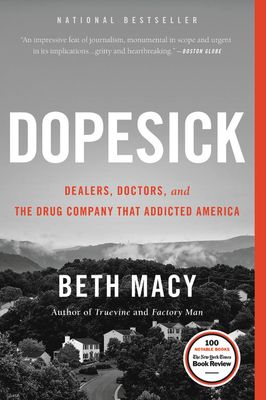Products You May Like
The new Hulu miniseries Dopesick takes on a Herculean task: Explore and explain the United States’ opioid crisis from the perspective of Purdue Pharma, the company that brought the addictive opioid OxyContin into the marketplace; the lawyers and government officials who investigated the company’s misleading branding of the drug; and the doctors and patients who bore the brunt of OxyContin’s devastating effects.
To do so, the series, adapted from the book of the same title by Beth Macy, presents four different timelines. One follows the fictional Bridget Meyer (Rosario Dawson) as a high-ranking Drug Enforcement Agency official trying to take down Purdue Pharma; the second follows Virginia prosecutors Rick Mountcastle (Peter Sarsgaard) and Randy Ramseyer (John Hoogenakker) who, in real life, conducted their own investigation into Purdue Pharma; the third follows Richard Sackler (Michael Stuhlbarg), the former president and board chairman of Purdue Pharma; and the fourth follows Dr. Samuel Finnix (Michael Keaton) and Betsy Mallum (Kaitlyn Dever), a fictional Virginia doctor and his patient. While the show’s thesis is clear—by downplaying the addictive qualities of OxyContin, Purdue Pharma contributed to an epidemic that’s affected millions of Americans—the various storylines means there’s a lot to keep track of.
To help make sense of it all, below you’ll find a guide to some of the real-life events depicted in Dopesick. However, if you don’t know much about the crisis, be warned: There are some spoilers for the show ahead.
January 1980
The New England Journal of Medicine publishes a five-sentence letter to the editor written by Jane Porter and Dr. Hershel Jick, which would later be used by Purdue Pharma to say that “less than one percent of patients treated with opioids became addicted,” per The Atlantic. The letter cites a single study, which only looked at hospitalized patients, and states, “We conclude that despite widespread use of narcotic drugs in hospitals, the development of addiction is rare in medical patients with no history of addiction.” Jick later told the Associated Press, “I’m essentially mortified that that letter to the editor was used as an excuse to do what these drug companies did.”
1989
J. David Haddox coins the now-debunked concept “pseudoaddiction,” which according to Wired, theorizes that addictive behavior is evidence of undertreated pain, and the solution is to prescribe even more opioids. Haddox would go on to become the vice president of health policy at Purdue.
December 1995
The FDA approves OxyContin, an opioid pain reliever, to treat moderate to severe pain. The drug comes into the market at a time when the U.S. medical community is rethinking the way it treats pain.
1996
Purdue Pharma launches sales of OxyContin.
1997
FDA examiner Curtis Wright, who oversaw the approval of OxyContin, leaves the agency. The next year, he begins working at Purdue Pharma with a $400,000 salary.
1998
Purdue Pharma distributed a promotional video titled “I Got My Life Back” to thousands of doctors, showing patients who say OxyContin improved their health. In 2012, the Milwaukee-Wisconsin Journal-Sentinel spoke to seven of the patients featured in the video and found two had an opioid use disorder when they died and a third person who developed an opioid use disorder lost her job and her house before getting off OxyContin.
This content is imported from YouTube. You may be able to find the same content in another format, or you may be able to find more information, at their web site.
1999
Richard Sackler, the mastermind behind the promotion of OxyContin, becomes president of Purdue Pharma.
Early 2000s
Incidents of overdose and drug-related deaths begin rising due to OxyContin. According to the FDA, “The number of people who admitted to using OxyContin for non-medical purposes increased dramatically from approximately 400,000 in 1999 to 1.9 million in 2002 and to 2.8 million in 2003.”
February 2000
The U.S. Attorney for Maine Jay McCloskey issues a letter to the state’s physicians warning about diversion and abuse of the drug. McCloskey said in a testimony for the Senate Judiciary Committee that he then organized a meeting with federal prosecutors, state and federal drug enforcement agents, local police chiefs, and Purdue Pharma executives in September 2000. This same year, OxyContin passes $1 billion in sales.
April 2001
FDA officials meet with Purdue Pharma to discuss the abuse of the drug, causing Purdue to suspend marketing of its 160-milligram OxyContin pill. The Clarion Ledger reports: “They worked together on a risk management plan to help prevent abuse of OxyContin, which included medical education programs for health care professionals, the retraining of sales professionals and the development of a national model for a state prescription monitoring program to prevent ‘doctor shopping.’”
Spring 2001
The DEA initiates an OxyContin National Action Plan, the first time in history that the agency “developed a plan to target a brand specific controlled substance with a focus on enforcement and regulatory investigations that targeted key points of diversion,” according to the Office of the Inspector General.
July 2001
FDA adds a new “black box warning” to the OxyContin label, drawing attention to its potential to be misused and abused. It also removed the sentence, “Delayed absorption as provided by OxyContin tablets is believed to reduce the abuse liability of a drug,” from the label, according to Marketplace.
2001
Richard Sackler says in a confidential email that Purdue would need to “hammer on the abusers in every way possible” as “the culprits and the problem” of the drug’s diversion and abuse, according to The Washington Post.
McCloskey ends his tenure as the U.S. Attorney for the District of Maine. McCloskey was one of the first federal prosecutors to bring attention to OxyContin abuse, according to Wired. After leaving government, McCloskey became a paid consultant for Purdue Pharma to work on reducing diversion and abuse, per his testimony.
February 2002
The Senate Committee on Health, Education, Labor and Pensions holds a hearing examining the effects of OxyContin and “focusing on federal, state and local efforts to decrease abuse and misuse this product…”
April 2002
Marianne Skolek Perez’s daughter dies from OxyContin use. As reported by Wired, Perez later buys an OxyContin pen off eBay, “one of the many small gifts the detail team distributed to doctors by the tens of thousands” and “an example of Purdue’s aggressive marketing tactics.” She also sets up the website OxyDeaths.com and attempts to take on Purdue Pharma for how it marketed the drug.
2002
Purdue Pharma hires Rudy Giuliani, who just ended his career as mayor of New York City, gaining widespread popularity for guiding the city through the 9/11 attacks. Giuliani was hired “to help stem the controversy about OxyContin,” according to The New York Times.
U.S. Attorney for the Western District of Virginia John L. Brownlee begins investigating Purdue’s marketing practices. He appoints Assistant U.S. Attorneys Randy Ramseyer and Rick Mountcastle to lead the investigation against Purdue.
January 2003
FDA issues a warning letter to Purdue Pharma for its misleading ads about OxyContin.
2005
After receiving calls from Purdue lawyers, then-Deputy Attorney General James Comey calls Brownlee to ask about his investigation. According to an excerpt of Dopesick published in Politico, Comey told Brownlee: “Go back to Virginia and do your case.”
May 2007
The investigation ends in a plea agreement. Purdue Pharma pleads guilty to criminally misbranding the drug and misrepresenting its risks of addiction. Three of its top executives plead guilty to misdemeanor “misbranding” charges, and the company and the executives pay a combined fine of $634.5 million, according to the Times. Purdue also admits that the company trained sales representatives “to tell doctors that OxyContin was less addictive and prone to abuse than competing opioids, claims beyond the one approved by the F.D.A.,” per the Times. While prosecutors recommended felony charges for the top executives, which could have resulted in prison time if they were convicted, Justice Department officials did not follow the recommendations.
April 2010
The FDA approves a new formula for OxyContin.
September 2019
Purdue Pharma files for bankruptcy. At the time, the company and the Sackler family were facing 3,000 lawsuits for contributing to the opioid crisis, according to the New York Post.
October 2020
Ending a long federal investigation, Purdue Pharma agrees to plead guilty to criminal charges related to the marketing of OxyContin, defrauding federal health agencies, and paying illegal kickbacks to physicians, according to the Times. Per the newspaper, the company faced penalties of roughly $8.3 billion, the largest imposed on a pharmaceutical manufacturer. The Sackler family also agreed to pay $225 million in civil penalties, a small fraction of their estimated $13 billion net worth.
2021
As recently as this August, Richard Sackler told a court that neither Purdue nor the Sacklers were responsible for the opioid epidemic. In September, a federal judge approved Purdue’s “bankruptcy reorganization plan,” which would resolve thousands of opioid-related lawsuits against the company and protect the Sackler family from future related litigation, according to the New York Post. (Though NPR reports the family would not be protected from criminal charges, only civil lawsuits.) The plan, per the Post, is to dissolve Purdue and shift assets to a new company “owned by a trust run to combat the opioid epidemic,” and have the Sacklers contribute $4.5 billion. Several states intend to appeal the ruling.
This content is created and maintained by a third party, and imported onto this page to help users provide their email addresses. You may be able to find more information about this and similar content at piano.io






